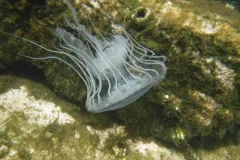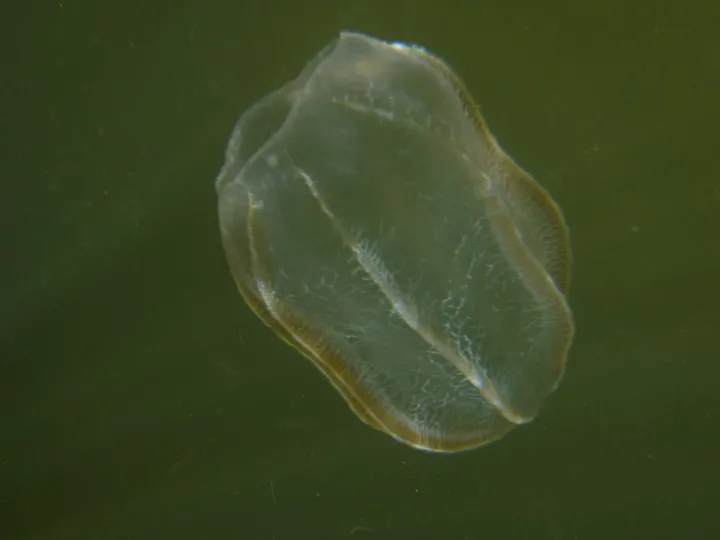Jellies in the Baltimore Harbor

In the Baltimore Harbor jelly-like creatures thrive. A city harbor, the waterway has a history of being a dumping ground for wastewater and trash, but recently efforts have made it clean enough for sea life to return. Jellyfish and comb jellies are some of the main marine species that inhabit the Baltimore Harbor in addition to a mix of fish, crabs, mussels, and other organisms. Hardy sea creatures, they show that life can endure in the harbor despite its polluted history. This is a heartening trend since the Baltimore Harbor makes up the waterfront of the city of Baltimore and is located within the watershed of the Chesapeake Bay, which is the largest estuary in the United States.
The city of Baltimore has served as a major seaport since the 18th century and has been used for trade with Europe and other locations around the world. Like the waterfronts of many cities in the United States, Baltimore once served as a focal point for numerous industries. This led to a dirty harbor filled with runoff and pollution, causing marine life to die-off. An area once known for its oysters and striped bass suddenly earned a reputation for being a toxic sea. Following the loss of domestic industries and manufacturing that occurred throughout urban areas in the country in 20th century, the leaders of Baltimore looked to revitalize the waterfront of the city to serve as a commercial, recreational, and tourism center. This included the development of numerous tourist attractions, hotels, restaurants, parks, plazas, entertainment venues, and residential areas as the city looked to move away from its industrial past. It also meant a cleaner harbor.
Jellyfish and comb jellies represent some of the oldest marine animal lineages in the world with a history that goes back at least 500 million years. While both types of organisms are made up of gelatinous tissue with some similarities in appearance and are transported by currents, they are in fact part of two different groups (phyla) with separate evolutionary paths: Cnidaria and Ctenophora. In general, jellyfish pulsate their bells to swim and feed with long, stinging tentacles while comb jellies use bands of hair-like cilia to move themselves through the water and feed with “sticky cells” on the ends of their appendages.
Through millions of years of evolution both have become proficient replicators. Jellyfish sexually reproduce and have a lifecycle much like a butterfly, with several different forms. For instance, they have tiny sausage-shaped larvae that metamorphosize into polyps that later give rise to mushroom-shaped adults, or the medusae. Most comb jellies, however, release both eggs and sperm at the same time and are capable of self-fertilization, which can sometimes lead to an extremely high reproductive rate. Though some exceptions remain sensitive to environmental change, most jellies are able to survive and persist even in unfavorable environments because of how they reproduce.
In some places around the world, large populations of jellyfish can be indicators of an unhealthy ecosystem. Some species thrive in environments affected by overfishing, rising water temperatures, and excess nutrient loading from runoff. Often, many predators or competitors of jellyfish, such as fish, have been removed from these highly developed environments, allowing the jellyfish populations to increase greatly. Floating larvae easily live in the ballasts of massive ships that cross the globe, which has allowed some species to become invasive. Furthermore, increased development of underwater man-made infrastructure like bridges and wind turbines has provided the larvae of some kinds of jellyfish with more hard surfaces to settle on to form polyps. Environments that become more favorable for certain species of jellyfish can allow massive outbreaks (known as blooms) to occur. Jellyfish blooms cause further harm to local ecosystems, including overconsumption of fish larvae and other organisms.
But in the Baltimore Harbor jellyfish are an indicator of an ecosystem on the mend. A wide variety of coastal and marine species are now known to live in the waters because of recent improvements in water quality. Although people generally associate these animals with the open ocean or a jellyfish sting while swimming at the beach, two species of jellyfish (bay nettle and lion’s mane jellyfish) and two kinds of comb jellies (sea walnut and pink comb jelly) typically inhabit the Baltimore Harbor. These species are often found in the Baltimore Harbor at various times of the year as they do throughout the wider Chesapeake Bay.
The bay nettle (Chrysaora chesapeakei) generally appears in the Baltimore Harbor in the late summer and early fall when salinity is higher and the water temperature is warmer. With their round, milky, white bells and long tentacles and oral arms, their numbers can vary greatly in the harbor from year to year depending on these variables in any given season. In addition to settling on oyster reefs as larvae, they have been known to help protect local oyster populations and fisheries in the bay by feeding on the sea walnut population, a type of comb jelly that also occurs in the harbor. Record rainfall in 2018 lowered overall salinity in the bay and led to a scarcity of nettles, which put oysters and other fisheries at risk when the hardy sea walnut exploded in number. Luckily, this important jellyfish species made a comeback in the following years.
When the harbor cools over winter, the bay nettle disappears, and the lion’s mane jellyfish (Cyanea fulva) comes to feed. While their close relative is known for their massive size when living at sea, the ones in the harbor are closer to the size of a dinner plate. These jellyfish generally prefer colder water temperatures (typically below 50°F). Although generally not as common in the harbor as the bay nettle found in the summer, lion’s mane jellyfish can be easily spotted since they often swim close to the surface and can come in a variety of beautiful red, orange, and sometimes pink and purple hues.
The sea walnut (Mnemiopsis leidyi) is the main type of comb jelly that occurs in the harbor along with the less common pink comb jelly (Beroe ovata). Both usually appear in the late summer and fall. While the sea walnut is typically translucent in appearance and is part of an order of comb jellies called lobates, which have two large lobes that extend along the sides of their oval bodies, the pink comb jelly is of the beroid order and typically pink or brown in appearance and oval. In the bay, the presence of both together is essential. In European waters and other regions, the sea walnut has become established as an invasive species, but in the Chesapeake its numbers are kept in check by both the bay nettle and the pink comb jelly. Pink comb jellies are such effective consumers of sea walnuts that when ships accidentally introduced them in Europe where the sea walnut population was out of control, they stabilized the overgrowth.
The occurrence of these species together in the Baltimore Harbor shows the unique role that jellyfish and comb jellies play within the ecosystem of the Chesapeake and in other urban harbors around the world. Healthy species relationships can exist within urban watersheds, even in a time when jellies get a bad reputation. These organisms show that rich coastal and marine ecosystems and species can exist right within our own backyard, which can help lead to increased stewardship of the oceans through inspiring people to become better connected to their local waterways.


